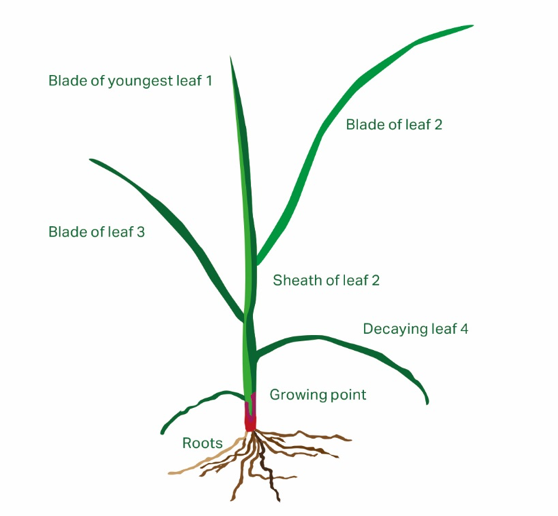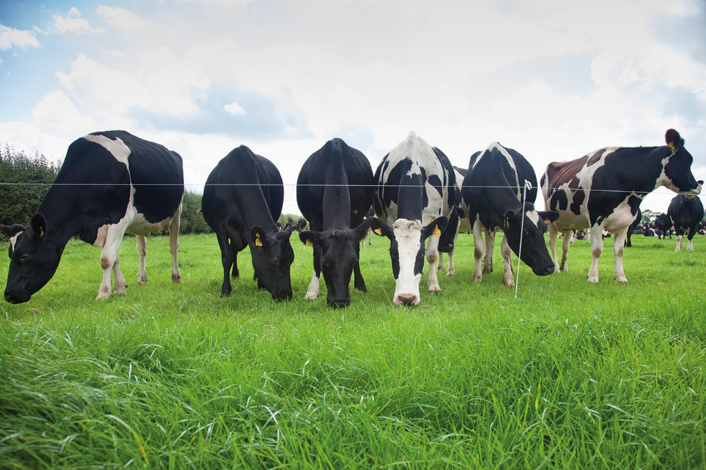If you want to maximise the nutritional value of grass, then effective grazing management is vital.
Regardless of whether livestock are set-stocked or rotationally grazed, the key is to assess pastures regularly (at least weekly) in order to establish when grass is at the right stage for grazing and when it is time to close an area to allow re-growth.
Methods to assess the condition of a sward for grazing include measuring sward height to establish the cover (kgDM/ ha), either with a calibrated sward stick or more simple aids, or using a rising plate meter.
Using the three-leaf system in grazing management
Whilst good and recommended practices, sward sticks and plate meters are primarily measurements of quantity whereas nutritional value is more related to quality. The established qualitative method of sward assessment is the Three-Leaf System.
This method is based on the understanding that a ryegrass tiller typically supports three green leaves.

The diagram shows the typical ryegrass tiller structure, including the youngest green leaf (leaf 1) growing at the top; two further green leaves (leaf 2 and leaf 3) that are no longer growing; and a dead and decaying leaf (leaf 4).
Monitoring the emergence of these leaves is commonly considered to be the best way to gauge the optimum pre- and post-grazing points in grazing swards, and planning the time that a given area will support grazing of the highest quality.
- The optimum pre-grazing stage is when the ryegrass tillers have at least two and a half and preferably three fresh leaves
- Grazing when there are less than two fresh leaves reduces plant vigour and re-growth potential
- Grazing when there are more than three leaves results in reduced sward productivity and reduced nutritional value as the proportion of dead and decaying material rises. In mixed swards, clover may be impeded due to excessive shading
Assessments should be made at least weekly prior to grazing, with more frequent counts in the spring when grass is growing most rapidly and less often in late autumn.
- Identify ryegrass from the red stem base
- Only use vegetative tillers (avoid anything with seed heads)
- Use the main parent tiller (as opposed to a daughter tiller)
- The youngest growing leaf when the grass was last grazed (near the base of the tiller, likely to have a blunt end)
- Assess the length of the remnant leaf in relation to the fresh un-grazed leaf above it
- If the remnant is more than half the length of the first fresh leaf, count it as 0.5-1, but if not it should not be counted
- If there is no remnant leaf, do not include this tiller in the assessment
- If there is more than one remnant leaf (because the sward was under-grazed previously) counting should start with the youngest remnant
- Start with the remnant leaf (as above)
- Each of the next full leaves count as 1.0
- The youngest (top) leaf may only be partly grown and should be assessed by its size relative to the previous leaf (this top leaf may not be immediately obvious but is often close to the previous leaf and can be revealed by opening the evident leaf by rolling it between thumb and forefinger)
- Select up to 10 tillers randomly across the field
- Calculate an average to create an accurate assessment
- An evenly grazed area will have most of the tillers assessed within a half leaf stage of each other.

Building and maintaining grazing infrastructure
The design and layout of grazing infrastructure is a vital element in maximising production from grass.
For a rotational grazing system for dairy cows, the following key points apply.
- Create the optimum number of paddocks for stock numbers and planned grazings per paddock
- Create track layout to reach all paddocks as efficiently as possible
- Allow multiple access points to each paddock
- Provide water to each paddock
- Rectangular paddocks give optimum grazing efficiency (optimum shape is a depth-to-width ratio of 2:1)
- Determine whether the tracks are for livestock only or will carry machinery (light or heavy) and construct accordingly
- Create a surface with hoof welfare and cow walking speed as the priorities and with sufficient camber for surface drainage
- Consider the time taken from paddock to farm (cows should walk at 2-3km/hr on a good surface)

Allow sufficient track width for the stock numbers (to avoid restrictions in flow); e.g. 250 cows require a 5.5 m wide track
- Avoid bends and sharp angles
- Provide sufficient water in all paddocks to meet peak demand; one or two troughs per paddock with sufficient pressure and flow rate to maintain availability
- Water intake averages 65 litres/cow/day but will vary from 10 litres on a cold wet day up to 140 litres on a hot day
- Up to 50% of a cow’s water intake may occur within an hour of milking
- Avoid water troughs on tracks as this will disrupt cow flow
- Design to allow the system to be drained during the winter
- Keep water troughs clean and free of debris.
For other helpful tips, check out this grassland reseeding guide.
